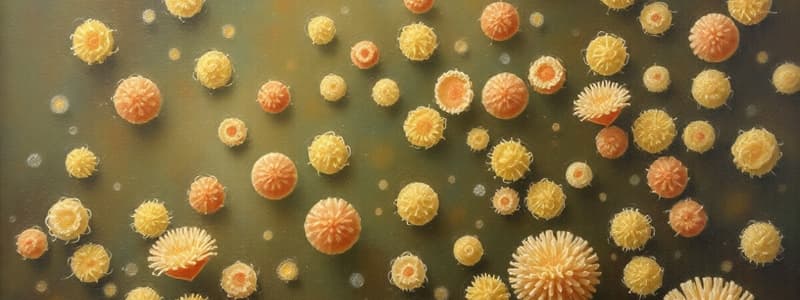Podcast
Questions and Answers
Which scientist is known for the discovery of penicillin?
Which scientist is known for the discovery of penicillin?
- Alexander Fleming (correct)
- Robert Koch
- Louis Pasteur
- Joseph Lister
What is the primary purpose of Gram staining?
What is the primary purpose of Gram staining?
- To identify bacterial species
- To differentiate between types of bacteria (correct)
- To determine the size of bacteria
- To measure bacterial growth
Gram-positive bacteria have a thinner peptidoglycan layer compared to Gram-negative bacteria.
Gram-positive bacteria have a thinner peptidoglycan layer compared to Gram-negative bacteria.
False (B)
Transformation refers to the uptake of foreign DNA by viruses.
Transformation refers to the uptake of foreign DNA by viruses.
What is the process by which bacterial cells divide called?
What is the process by which bacterial cells divide called?
What are the four phases of the microbial growth curve?
What are the four phases of the microbial growth curve?
_____ are known for their importance in ecosystems, specifically in the process of photosynthesis.
_____ are known for their importance in ecosystems, specifically in the process of photosynthesis.
Match the following types of media with their descriptions:
Match the following types of media with their descriptions:
_____ are organisms that can grow in high salt concentrations.
_____ are organisms that can grow in high salt concentrations.
Which of the following techniques is used for isolating individual microbial colonies?
Which of the following techniques is used for isolating individual microbial colonies?
Match the following control methods with their descriptions:
Match the following control methods with their descriptions:
Which of the following is NOT a method for measuring microbial growth?
Which of the following is NOT a method for measuring microbial growth?
Eukaryotic cells are generally smaller and simpler in structure than prokaryotic cells.
Eukaryotic cells are generally smaller and simpler in structure than prokaryotic cells.
Chemical disinfectants are effective against all types of microorganisms without exception.
Chemical disinfectants are effective against all types of microorganisms without exception.
What is the primary purpose of staining techniques in microbiology?
What is the primary purpose of staining techniques in microbiology?
Explain the main mechanism by which antibiotics function.
Explain the main mechanism by which antibiotics function.
Flashcards
Germ theory of disease
Germ theory of disease
The concept that infectious diseases are caused by microorganisms.
Koch's postulates
Koch's postulates
A set of rules to determine if a specific microbe causes a particular disease.
Binary fission
Binary fission
A type of asexual reproduction in bacteria, where one cell divides into two.
Gram-positive bacteria
Gram-positive bacteria
Signup and view all the flashcards
Microbial taxonomy
Microbial taxonomy
Signup and view all the flashcards
Serial dilution
Serial dilution
Signup and view all the flashcards
Prokaryotic cells
Prokaryotic cells
Signup and view all the flashcards
Differential stain
Differential stain
Signup and view all the flashcards
Gram Staining
Gram Staining
Signup and view all the flashcards
Transformation
Transformation
Signup and view all the flashcards
Transduction
Transduction
Signup and view all the flashcards
Conjugation
Conjugation
Signup and view all the flashcards
Growth Curve Phases
Growth Curve Phases
Signup and view all the flashcards
Microbial Growth Measurement
Microbial Growth Measurement
Signup and view all the flashcards
Factors Affecting Microbial Growth
Factors Affecting Microbial Growth
Signup and view all the flashcards
Food Microbiology Principles
Food Microbiology Principles
Signup and view all the flashcards
Study Notes
Scope and Application of Microbiology
- Microbiology is the study of microscopic organisms, including bacteria, viruses, fungi, and algae.
- Applications span health (disease diagnosis and treatment), industry (food production, bioremediation), agriculture (fertilizer production, pest control), and environmental science (pollution control).
Contributions and Role of Scientists in Microbiology
- Louis Pasteur established the germ theory of disease.
- Robert Koch developed Koch's postulates to link specific microorganisms to specific diseases.
- Alexander Fleming discovered penicillin, a crucial antibiotic.
- Joseph Lister pioneered aseptic techniques to reduce surgical infections.
Basic Description of Different Types of Microorganisms
- Bacteria: Single-celled prokaryotes with diverse shapes and functions.
- Viruses: Non-cellular entities requiring a host cell for replication.
- Fungi: Eukaryotic organisms like molds and yeasts, often decomposers.
- Algae: Photosynthetic organisms playing vital roles in aquatic ecosystems.
General Features of Gram +ve and Gram -ve Bacteria
- Gram-positive bacteria possess a thick peptidoglycan layer in their cell walls.
- Gram-negative bacteria have a thin peptidoglycan layer, and an outer membrane.
- Gram staining differentiates these based on cell wall structure.
Structure, Function, and General Application of Prokaryotic and Eukaryotic Cells
- Prokaryotic cells (e.g., bacteria) lack a nucleus and membrane-bound organelles.
- Eukaryotic cells (e.g., fungi, plants, animals) have a nucleus and membrane-bound organelles.
- Prokaryotes are substantially simpler in structure compared to eukaryotes.
Microbial Taxonomy and Microbial Phylogeny
- Taxonomy classifies microorganisms based on shared characteristics.
- Phylogeny describes evolutionary relationships between microorganisms based on genetic analysis.
Bacterial Reproduction
- Binary fission is the primary asexual reproductive method in bacteria, resulting in two identical daughter cells.
- Other methods of bacterial reproduction exist, notably exchanging genetic material.
Tools and Techniques Used in Microbiology I
- Microscopy (light and electron) is crucial for visualizing microorganisms.
- Staining techniques enhance visibility and identification of microorganisms.
Tools and Techniques Used in Microbiology II
- Culture techniques isolate and grow microorganisms in controlled environments.
- Molecular techniques (e.g., PCR, sequencing) are powerful tools for studying microbial genomes.
Microbial Nutrition and Media
- Microorganisms require various nutrients (carbon, nitrogen, sulfur, phosphorus) for growth.
- Media types (defined, complex, selective, differential) support specific microbial growth.
Types of Media
- Solid media use agar to solidify growth mediums.
- Liquid media (broth cultures) are used for microbial growth in liquid solutions.
Serial Dilution
- Serial dilution reduces microbial concentration for precise counting.
- This is vital for determining the number of viable cells in a sample.
Plating, Streaking, and Spreading of Culture Media
- These techniques isolate distinct colonies of microorganisms on the growing surface.
Maintenance and Preservation of Pure Cultures
- Techniques like refrigeration, lyophilization (freeze-drying), and cryopreservation maintain microbial cultures.
Staining Techniques: Principle and Application
- Staining is crucial for visualizing microorganisms and differentiating various species.
- Simple stains color all cells.
- Differential stains differentiate based on structure and characteristics (e.g., Gram stain, acid-fast stain).
- Special stains highlight specific cellular structures within microorganisms.
Types of Staining Methods
- Gram staining differentiates gram-positive and gram-negative bacteria.
- Acid-fast staining targets bacteria like Mycobacterium species with a waxy cell wall.
Microbial Growth and Division: Transformation
- Transformation is the uptake of foreign DNA by a bacterium.
Microbial Growth and Division: Transduction
- Transduction is the transfer of genetic material by bacteriophages.
Microbial Growth and Division: Conjugation
- Conjugation is direct genetic exchange between bacterial cells, often via pili.
Growth Curve: Definition and Expression
- A growth curve depicts the pattern of microbial growth over time.
- Phases include lag, exponential, stationary, and death phases.
Measurement of Growth Curve
- Methods like optical density, plate counts, and direct counting measure microbial growth.
Factors Affecting Microbial Growth (Temperature, pH, Water Activity)
- Temperature impacts microbial growth, with specific optimal ranges.
- pH levels affect microbial activity, with some thriving in acidic or alkaline conditions.
- Water activity is the availability of water for microbial use and influences the growth of microbes in various environments.
Factors Affecting Microbial Growth (Oxygen Concentration, Salt Concentration)
- Oxygen requirements vary among bacteria (aerobes, anaerobes).
- Salt concentration affects growth depending on microbes, particularly halophiles.
Factors Affecting Microbial Growth (Pressure and Radiation)
- Pressure and radiation are environmental factors affecting whether microorganisms can grow or survive.
Control of Microorganisms: Definition and Types
- Control methods fall into physical, chemical, and biological categories.
Different Groups of Chemotherapeutic Agents
- Antibiotics target bacterial cells.
- Antiseptics/Disinfectants are used for topical treatment and sterilization.
Chemotherapeutic Agents and Their Mechanism of Action
- Antibiotics inhibit processes like cell wall synthesis.
- Antifungals/Antivirals target different cellular components for specific treatments.
Physical Methods: Heat, Filtration, and Radiation
- Heat (autoclaving, boiling) and filtration sterilize materials.
- Radiation (UV, ionizing) damages microbial DNA, potentially sterilizing environments.
Chemical Methods: Alcohol, Aldehydes, Phenols
- Alcohols, aldehydes, and phenols are chemical methods for controlling microbes.
Chemical Methods: Halogen, Metallic Salts, Quaternary Ammonium Salts
- Halogens, metallic salts, and quaternary ammonium compounds control microbes and are often relevant in sanitation.
Sterilizing Gases as Antimicrobial Agents
- Sterilizing gases such as ethylene oxide and hydrogen peroxide gas disrupt DNA and kill microorganisms.
Public Health Microbiology
- Public health microbiology addresses microbial threats to human health.
- Surveillance for emerging pathogens is critical for controlling diseases.
Food Microbiology: Principle, Preservation, and Different Techniques Used in Food Microbiology Part 1
- Food microbiology examines beneficial and harmful microorganisms in food preservation.
- Techniques for food preservation include canning, refrigeration, and drying.
Food Microbiology: Principle, Preservation, and Different Techniques Used in Food Microbiology Part 2
- Fermentation has a role in food production (yogurt, bread).
- Food safety controls microbial growth during food production and preservation.
Studying That Suits You
Use AI to generate personalized quizzes and flashcards to suit your learning preferences.
Description
This quiz covers the scope and applications of microbiology, including the roles of bacteria, viruses, fungi, and algae. It also highlights key contributions from prominent scientists like Louis Pasteur and Alexander Fleming that shaped the field. Test your knowledge on the importance of microorganisms in health, industry, agriculture, and environmental science.




